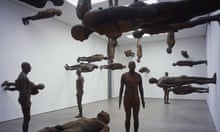The architect Sir David Chipperfield would be quite happy if you visited his £56m expansion of the Royal Academy of Arts and couldn’t quite tell what he had done. Unlike the British Museum’s Great Court or Tate Modern’s Switch House, the illustrious Piccadilly pile in central London celebrates its 250th birthday with less of a flashy architectural statement than a series of discrete acts of corrective surgery – which, together, promise to transform the entire institution.
“I’m hoping this might take us from one star in the Michelin guide to two or three,” says Charles Saumarez Smith, the RA’s chief executive. “We’ve never really been a destination for cultural tourists before, as there hasn’t been much to see between the big shows.”
He hopes that will change, with 70% more public space now excavated out of the institution’s two-acre campus following an intricate jigsaw puzzle of stitches and connections that brings a sense of coherence and intelligence to the rambling complex.
Ten years in the making, the anniversary project has seen the RA’s historic home of Burlington House linked to its rear neighbour, 6 Burlington Gardens, for the first time. Visitors will be able to walk from Piccadilly to Mayfair, via an atmospheric subterranean vault and an enticing glimpse of the RA Schools’ art studios, to a new suite of galleries, a lecture theatre, cafes and shops.
What Chipperfield describes as his “diagnostic, punctual interventions” range from simply stripping back and whitewashing some spaces, to inserting a new bridge between the buildings that punches through one of the school’s studio walls, as if it had been ramraided by a concrete lorry. Before conservationists cry heresy, it is a fitting disruption to the workmanlike studios, themselves housed in a lean-to shed of exposed steel beams and rivets.
One of the happiest consequences of the need to link the two buildings is that the messy, energetic life of the RA Schools, the free postgraduate art school, which has always been hidden away beneath the floorboards of the genteel galleries, is now present.
From Burlington House, visitors are first taken below stairs into a tall, brick-vaulted corridor, elegantly scrubbed into a ghostly grey pallor and lined with ghoulish casts of flayed corpses, historically used for anatomical drawing.
From here, you cross the schools’ corridor, full of more casts and curios, into a former studio now used for changing displays of student work, before heading through Chipperfield’s momentous concrete portal and up into Burlington Gardens beyond.
It is an illuminating journey through the bowels of the building that might shift people’s perceptions of the RA, from an ossuary of Academicians to a vital place where contemporary art is being made.

Such a brazen move was not straightforward in the byzantine world of this privately funded academy, run by its opinionated artist members. “Knocking a hole through a brick wall is easy,” says Chipperfield, who was elected to the RA in 2007. “Negotiating with an institution like this is very complex. It was a lengthy process of territorial land-swapping between the different tribes.”
The politicking was worth it. Once across the bridge, you discover Burlington Gardens has been transformed. Built as the Italianate headquarters of the University of London in 1870, the building was acquired by the RA in 2001 and has been used occasionally for exhibitions, but never much loved. The enormously grand staircase and ceremonial corridors have always outbalanced the rather perfunctory rooms, divided up as offices over the years. There had been previous attempts to unite the two buildings, but both had run aground: the first, by Michael and Patty Hopkins in 2001, was overblown; the second, by Colin St John Wilson in 2007, was too subtle.
Chipperfield’s approach feels just right: like his celebrated work on the Neues Museum in Berlin, it strikes the balance between deference and forcefulness, knowing when to be bold and when to stay quiet.
Former labs and offices have been opened up, their raw stone floors revealed, roof lights reinstated and a new floor inserted in a former void to create a continuous run of three galleries, where Tacita Dean’s powerful opening show on landscape sets the tone.
The west wing has been turned into a free gallery for the permanent collection, where a 1506 copy of The Last Supper (a startling record of Leonardo’s now-faded masterpiece) hangs alongside works by Michelangelo, Gainsborough and Constable in a potted history of the RA.
Next door, the conservation architect Julian Harrap has been allowed to let rip in the Senate Rooms, returning them to their polychromatic glory as the theatrical setting for a bar. It doubles up as the ripe foyer for a dedicated architecture space, formerly relegated to a dingy corridor on the way to the cafe.
Finally, the masterful highlight is the new lecture theatre, excavated out of a double-height volume in the east wing. A modern interpretation of a horseshoe operating theatre, of the kind where gruesome dissections would have taken place, it is surrounded by tall windows on all sides, allowing light to be shed on the RA’s lively programme of discussions and debates – a rare delight compared with most black-box auditoria.
When the building opens next week, it seems apt that the first specimen on the operating table will be Chipperfield himself, whose surgical interventions have given this unwieldy place a new lease of life.









Comments (…)
Sign in or create your Guardian account to join the discussion